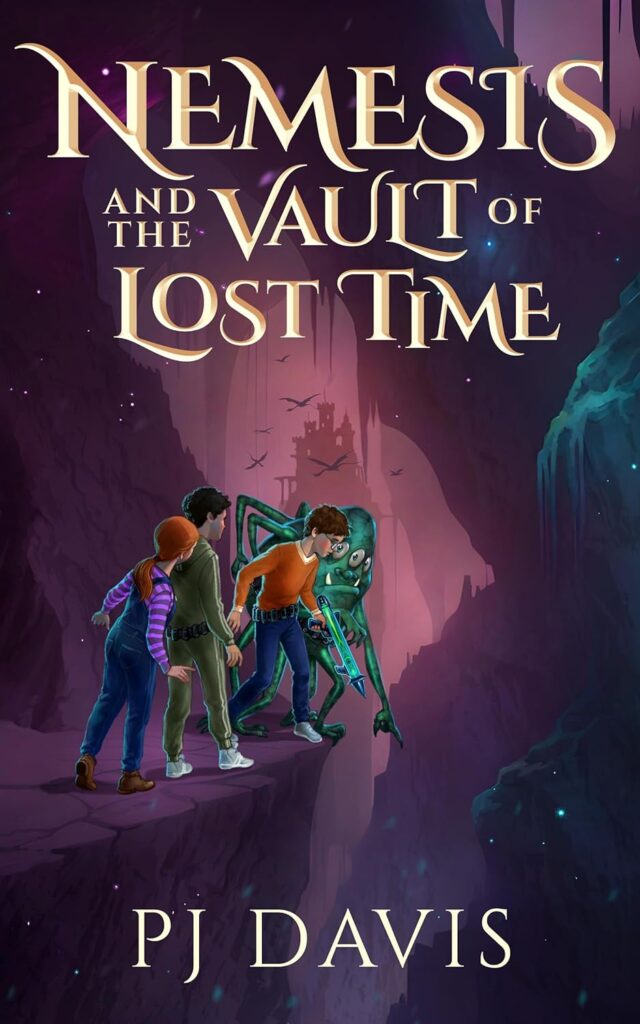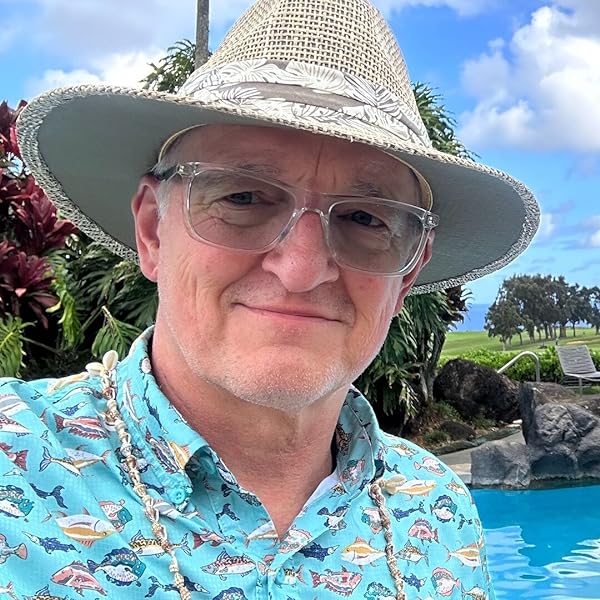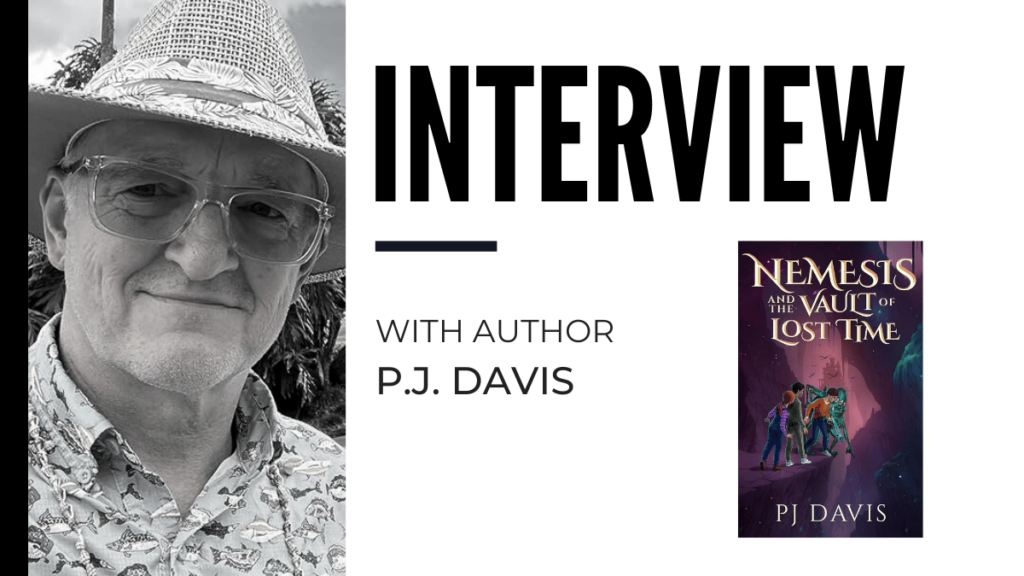An interview about Nemesis and the Vault of Lost Time, presented in partnership* with P. J. Davis and The Children’s Book Review.
In this exclusive interview with P.J. Davis, the mastermind behind Nemesis and the Vault of Lost Time, we delve deep into the inspirations and messages woven intricately throughout this captivating tale.
From the impromptu storytelling style that birthed the narrative to the fusion of science and fantasy, Davis shares the essence of his creative process. Through Max Kellerman’s relatable struggles and the enduring power of friendship, we uncover profound insights into the human experience. Davis sheds light on the universal theme of time scarcity and the importance of self-discovery amid life’s chaos. As the adventure unfolds, readers are encouraged to embrace their inner voices and navigate the intricate dance between dreams and reality.
With hints at future escapades, Davis leaves us eagerly anticipating the next chapter in Max’s journey and the resolution of his father’s mysterious disappearance. Dive into the enchanting world of Nemesis and the Vault of Lost Time as we unravel its secrets and embark on a quest for truth and adventure.
Tell us a little bit about the inspiration for Nemesis and the Vault of Lost Time.
P.J. Davis (PJD): Where to begin? They say writers fall into two camps – planners and “pansters.” Planners have a general idea of their story and then develop it. Pansters write by the seat of their pants, following an inner prompt or lead and then watching as the story unfolds. This was very much the case for me. I felt an urge to write this story, and then it just seemed to pour out, sometimes in fits and spurts. So, in many ways, it was more of an act of listening for it and then letting the story reveal itself. At one point in the story, I stopped writing because I couldn’t believe what just happened!
We love the elements of science woven through the story alongside the fantasy. Why do you think blending these two elements makes such a good story?
PJD: If art imitates life, why can’t fantasy imitate science? It’s always been an interwoven play. Einstein famously said that imagination was more important than knowledge, but only in the sense that what’s known is finite, whereas what’s unknown is infinite. Premonitions today become the knowledge and science of tomorrow. Things we only imagined in movies a few years ago are now everyday reality.
We all know a daydreamy kid like Max, who seems to have an awful time at school. Is his experience based on experience from your life or someone you know?
PJD: In some ways, all novels are autobiographical. As authors, we draw from the well of personal experience, which informs our writing. I was very much this kid. I started kindergarten at four years old, so I was always younger than my classmates. I frequently daydreamed, had trouble staying on task, asked teachers too many questions (because I was insatiably curious), and had a vivid imagination. This went over well with a small handful of teachers but not so much with others. That’s why it’s not uncommon for kids to feel a bit lost. overlooked or misunderstood during these very formative years. There’s a lot going on at school, and not every kid has an advocate.
For readers who don’t already see themselves in Max, what is Max’s message to them?
PJD: For Max, with all this frenetic activity, all this commotion and information swirling around him, it’s about tuning in, listening, and trusting his inner voice – that quiet one that tells you things you already know on some level but choose to ignore. I think we all have that inner witness, a guide, so to speak, if we can block out the noise long enough to hear it.
Max wouldn’t get very far on his adventure without his two best friends. Tell us a bit about the role friendship plays in the messaging and plot of the novel.
PJD: Friendship is foundational, pure and simple. It’s what helps keep us sane in our journey, that trusted cohort that has our back and believes in us, and goes to bat for us, but also cares enough to challenge us. For Max, he needs these friends, whether he realizes it or not. They are his grounding rods, his comrades-in-arms. And in the story, in the proverbial heat of battle, these bonds of friendship fuse and grow stronger. Maybe that’s why we say we “forge friendships.” They result from going through good times and bad and coming out all the better for it.
Not having enough time feels like such a common problem in our society. Do you think this is a plot element a lot of young readers can relate to?
PJD: If there ever was an age when everything was a “time suck,” this would be it! Kids now have all the pressures we as adults had as children, plus the enormous pull/drain of a dual digital life. I really can’t imagine it. Creativity often comes in the quiet moments of life, e.g. wondering, pondering, imagining, etc. So finding that time to unplug, relax, and, yes, I’ll say it, daydream every now and then is vitally important. Sometimes we have to take a break from the tyranny of the urgent to experience the magic of the present.
Max manages to succeed in his quest despite many people’s low opinion of him. What advice do you have for readers who feel under-appreciated by the people in their lives?
PJD: Do NOT despair! You have value beyond anything that can be imagined, but you can’t look to outside sources for that validation. It comes when it comes, in ways you might not expect, so don’t let outside sources be the determinant of your self-worth; it’s an inside job. You are a key that fits a certain tumbler, and what you discover and unlock in life will come to you over time.
If you would like readers to learn one thing from reading this novel, what would it be?
PJD: I think every reader will take away what they need to take away from this story. I’m not sure there’s a single message, it’s more meant to resonate, to create a vibration of sorts, that in turn begins a quest.
What other favorite quest stories would you recommend to readers who have enjoyed Nemesis and the Vault of Lost Time?
PJD: The hero’s journey is the crux of many great children’s classics. The Lion, the Witch, and the Wardrobe, The Wizard of Oz, Journey to the Center of the Earth, A Wrinkle in Time, even Charlie and the Chocolate Factory, and James and the Giant Peach. My favorite two growing up were From the Mixed-Up Files of Mrs. Basil E. Frankweiler and The Twenty-One Balloons. Both inspired me for different reasons. But all the fantastical fantasy adventures serve the important purpose of fueling the imagination.
We’ve been left with a cliffhanger about Max’s father – are there more adventures planned for Max and his friends? Will Max and his father be reunited?
PJD: That’s a very, very good question. Max’s father may be missing, but missing is not the same as gone. “Transitions are messy,” they always are. I think there might be more adventures ahead for Max, Sam and Derek, especially given the last illustration at the end of the book.
About the Book

Nemesis and the Vault of Lost Time
Written by P.J. Davis
Illustrated by Thomas Peacock
Ages: 8+ | 234 Pages
Publisher: Philaments | ISBN-13: B0CVS2P3N3
Book Summary: “…it’s hard to prove the world’s most important substance is missing when no one knows it’s gone.”
“Substance? What substance?” asks thirteen-year-old Max Kellerman. “Why time itself!” exclaims the strange professor whom Max meets in the back of his uncle’s bookstore. In fact, he says, time is being sucked out of every living person by invisible thieves and stored away in a deep, dark netherworld.
Could the professor possibly be right… or just plain crazy?
It depends on whether Max can unravel the mysterious clues in the tattered manuscript the professor leaves behind. With the help of his best friends Derek and Samantha, Max begins a quest to find this dark realm and discover its hidden secrets. But with the time clock ticking and the professor gone missing, Max uncovers a truth he never thought possible.
Max must unravel the mysteries of Nemesis to save not just his world but the very fabric of time itself.
Get a FREE Nemesis and the Vault of Lost Time Activity Kit Printable: Download Here
Buy the Book
About the Author
PJ Davis lives in the tiny mountain town of Brevard, North Carolina, overlooking the Blue Ridge Mountains. He lives there with his wife, youngest son, three sleepy cats, and three noisy ducks. For his day job, he names things, such as companies, products, and services. he even named the town’s annual White Squirrel Festival.
PJ is a nickname, short for Phillip John. It is the type of long, formal-sounding name that parents use when they are really mad about something you did and for which you are about to get into serious trouble. As a child, PJ was a bit like his book character Max and also suffered from ACHOO syndrome, along with bouts of intense curiosity and daydreaming. Growing up, almost all of his questions started with “what if…” which drove his parents crazy.
For more information, visit http://www.PJDavisAuthor.com

About the Illustrator
Tom Peacock is an artist extraordinaire with an extensive background in illustration and graphic design. His work as an agency art director and subsequent roles in marketing and art direction make him an in-demand talent. Tom is not a native of North Carolina but moved there as soon as he could. When not drawing, off-roading or selling mountain real estate, Tom can most likely be found in the woods.

This interview—An Interview with P. J. Davis, Creator of ‘Nemesis and the Vault of Lost Time’—was conducted between P. J. Davis and Dr. Jen Harrison.


1 Comment
My dogs like to go for rides in the car because they get ice cream & ice water on the way home lol